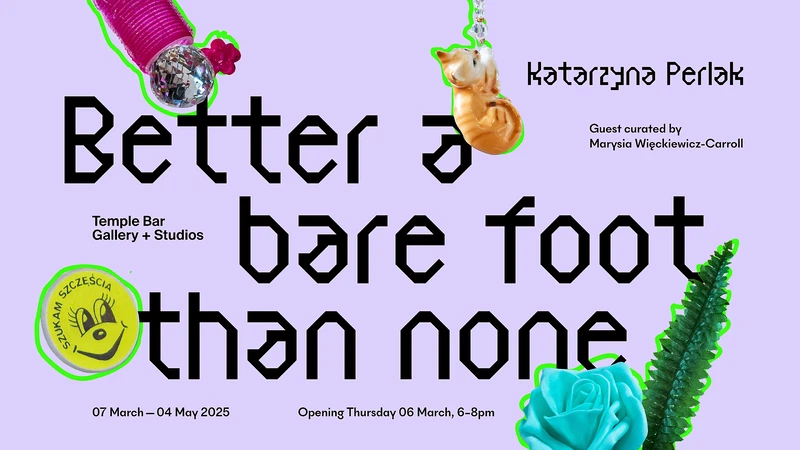Katarzyna Perlak, 'Better a bare foot than none'
7 Mar-4 May 2025
PV 6 Mar 2025, 6-8pm


Temple Bar Gallery + Studios presents Better a bare foot than none is Katarzyna Perlak’s first public solo exhibition. It is part of a series of exhibitions curated by Marysia Więckiewicz-Carroll responding to shifting political landscapes in Ireland and Poland .
Katarzyna Perlak’s practice is deeply embedded in folk traditions, queer narratives and diasporic identity. Using video, performance, textiles, sculpture, and installation, Perlak’s work is often defined by an aesthetic of abundance—assemblages of kitsch ephemera and everyday objects sourced at local flea markets and second-hand shops that speak to memory, longing, and reimagined heritage. Through craft, storytelling and the materiality of memory, Perlak envisions new ways of connecting to the past while forging space for alternative futures.
Brought up in Bytom, a mining city in Poland’s Upper Silesia region, Perlak experienced a crossroads of political transition, witnessing both the city’s industrial prosperity and post-communist decline. Historically, the region was a confluence of diverse cultures and traditions, rich in folklore and unique customs, with its own distinct clothing style and dialect. The traditional attire was vibrant and intricately adorned, featuring elaborate embroidery, soft pastel silk ribbons and striking beaded necklaces. Young unmarried women would wear galanda, an opulent garland crafted from artificial flowers and decorative trinkets, with cascading ribbons that swayed rhythmically as they moved. Under communist rule, from the late 1940s onwards, these costumes became largely confined to staged performances by folk and song ensembles, serving as curated relics of cultural heritage rather than expressions of everyday identity.
Perlak scrutinises how these relics have been deployed as tools to reinforce dominant historical narratives. Her engagement with folklore and craft serves as an act of reclamation, challenging how tradition is shaped by power structures through the erasure of marginalised histories. In her film essay, Niolam Ja Se Kochaneczke (2016), she reinterprets Polish folk aesthetics through a queer lens, questioning the official state narratives that often excluded LGBTQ+ existence. In a moment of rising conservatism in Poland, where homosexuality has historically been framed as a foreign influence, Perlak’s work affirms the presence of queerness within Eastern European heritage.
Her 'tender crafts' methodology furthers this exploration by reinterpreting traditional handwork practices from feminist, migrant and queer perspectives. Perlak employs the concept to examine how heritage and traditions can be reclaimed and reimagined as sites of resistance and care. She engages with ‘affective truths’—myths, folktales, dreams, desires, and collective memories—to question the ways history is recorded and traditions are framed. Through intricate, labour-intensive processes, her work elevates overlooked domestic crafts, transforming them into powerful tools for storytelling, intimacy, and cultural critique.
For this exhibition, Perlak expands her research into Polish Pajaki—ornamental paper ‘spider’ chandeliers historically assembled for Christian, pagan, and folk celebrations. Traditionally hung as protective symbols within the home, Perlak reimagines them as queer talismans, emblematic of resistance and belonging. Composed of found objects, including artificial flowers, discarded photographs, and second-hand ornaments sourced in the artist’s hometown of Bytom, Dublin and London, these sculptures weave together the personal and the political, nostalgia and possibility.
Suspended within the Gallery, Perlak’s Pajaki sculptures require close observation, revealing layers of symbolism and significance embedded within their intricate forms. The sculpture Poplar Time (2025) becomes a meditation on domesticity and the instability that comes with displacement. The ‘spider’s’ base is made of anti-climb fencing material regularly installed around Poplar, an inner-city London suburb where the artist currently lives. The attached constellation of wristwatch parts symbolises temporality and precarity of housing in the area that is undergoing demolition. The visual vibrancy of Ruta Time (2022), with its fusion of platform shoes, kitsch flowers, and sparkly masks, intertwines folk traditions with a queer aesthetic of abundance, revealing complex and multifaceted histories.
In her textile works, Perlak delves into vernacular stories and proverbs, referencing words and phrases that convey resilience and highlight the emotional weight of what is lost or misinterpreted in translation. The tapestry titled Cos za Cos (2025), loosely translated as ‘you win some, you lose some,’ foregrounds the challenges of fully articulating one’s identity and the associated feelings of loss and longing. It incorporates the iconographic motif of a deer, a symbol commonly found in Polish ethnoart and associated with folk culture and mass-produced imagery. Perlak’s engagement with kitsch recurs throughout her practice, interrogating the boundaries between authenticity and sentimentality.
Building on her Bated Breaths series (2020–ongoing), Perlak’s embroidered handkerchiefs feature individual and collective phrases, that serve as intersections of personal history, shared memory, and cultural etiquette. Traditionally used to absorb bodily fluids and suppress emotions, handkerchiefs also function as tools of communication— from folk dances to coded LGBTQ+ identity markers. These textiles carry layered symbolic meanings, simultaneously personal and communal. In this exhibition, the handkerchiefs evolve further, embodying the shared economic precarity linked to cultural displacement. Wszędzie dobrze, gdzie nas nie ma (2025), meaning ‘the grass is always greener,’ expresses the emotional landscape of migration—homesickness, longing, and the imagined elsewhere. The repeated act of stitching the same sentence over and over becomes a meditative ritual, an intimate yet powerful expression of searching for home, capturing a stillness found in compulsive repetition.
Katarzyna Perlak’s exhibitions include Liverpool Biennial (2025); V&A Museum, London (2024); Whitechapel Gallery, London (2023); B3 Biennial of Moving Image, Frankfurt (2023); Brent Biennial, London (2022); Jerwood Arts, London (2021); Detroit Art Week (2019); Bloomsburg New Contemporaries, BALTIC, Gateshead (2017); Diaspora Pavilion, 57th Venice Biennale (2017).
Marysia Więckiewicz-Carroll has organised and curated numerous exhibitions and projects in Ireland and abroad, independently and in partnership with various institutions and local authorities, including Hugh Lane Gallery and Irish Museum of Modern Art, Dublin. She was a co-editor of Paper Visual Art, and the founding director of Berlin Opticians Gallery.
This exhibition is supported by an Arts Council Project Award.